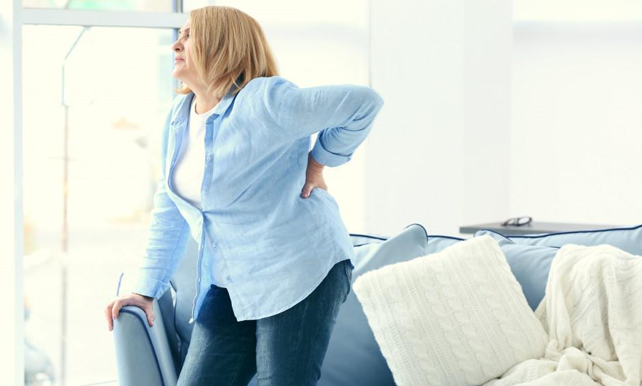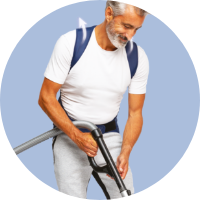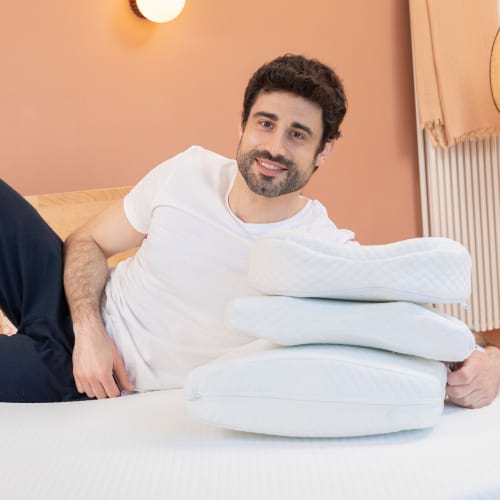
Lower Back Pain (Lumbago)
Pain in the lower back (lumbago) is particularly common, although it can be felt anywhere along the spine, from the neck down to the hips. In most cases the pain is mechanical in nature and is not caused by anything serious. It is usually linked to one or more structures of the spine (joints, ligaments, muscles, discs etc.).
- 1. What is back pain?
- 2. What are the causes of back pain?
- 3. Treatment and prevention of back pain
- 4. PERCKO, a long-term complementary solution

1. What is back pain?
Pain in the lower back (lumbago) is very common and is felt in the lumbar vertebrae. Lower back pain can last from a few days to several years. In most cases, the pain is not caused by anything serious and will usually get better over time. There are things you can do to help relieve it but sometimes the pain can last a long time or keep coming back (when it lasts more than 3 months it is considered chronic).
Exceptionally, and in less than 1% of cases, lower back pain can be related to inflammation (infection, tumour, spondylitis etc.) or a fracture due to trauma or osteoporosis. In case of spontaneous onset of pain without trauma, being woken up in the night due to pain, or a general deterioration of your well being due to pain, immediately seek the advice of your doctor and stop the use of PERCKO products (see medical device contraindications).
2. What are the causes of back pain?
Lower back pain can have many causes. Most often, it can be caused by triggers such as:
- Sudden or impactful movements
- Prolonged effort
- Positions held for too long
- Repetitive movement
Lower back pain originating from such triggers, mainly mechanical, are not serious but can be disabling and interfere with daily life. Lower back pain is regularly exacerbated by carrying heavy loads, prolonged sitting and overexertion.
Occasionally back pain can be caused by a medical condition such as:
- a slipped disc – where a disc of cartilage in the spine presses on a nearby nerve
- sciatica – irritation of the nerve that runs from the pelvis to the feet
These conditions tend to cause additional symptoms, such as numbness, weakness or a tingling sensation, and they're treated differently from non-specific back pain.
3. Treatment and prevention of back pain
How to relieve back pain
The following tips may help reduce your back pain and speed up your recovery:
- Stay as active as possible and try to continue your daily activities – this is 1 of the most important things you can do, as resting for long periods is likely to make the pain worse
- Try exercises and stretches for back pain; other activities such as walking, swimming, yoga and pilates may also be helpful
- Take anti-inflammatory painkillers, such as ibuprofen – remember to check the medicine is safe for you to take and ask a pharmacist if you're not sure
- Use hot or cold compression packs for short-term relief – you can buy these from a pharmacy, or a hot water bottle or a bag of frozen vegetables wrapped in a cloth or towel will work just as well
Although it can be difficult, it helps if you stay optimistic and recognise that your pain should get better. People who manage to stay positive despite their pain tend to recover quicker.
Back pain usually gets better on its own within a few weeks or months and you may not need to see a doctor or other healthcare professional.
But it's a good idea to get help if:
- The pain does not start to improve within a few weeks
- The pain stops you doing your day-to-day activities
- The pain is very severe or gets worse over time
- You're worried about the pain or struggling to cope
- If you see a GP they will ask about your symptoms, examine your back and discuss possible treatments.
They may refer you to a specialist doctor or a physiotherapist for further help.
Treatments for back pain from a specialist
A GP, specialist or physiotherapist may recommend extra treatments if they do not think your pain will improve with self-help measures alone.
These may include:
- Group exercise classes where you're taught exercises to strengthen your muscles and improve your posture
- Manual therapy treatments, such as manipulating the spine and massage, which are usually done by a physiotherapist, chiropractor or osteopath
- Psychological support, such as cognitive behavioural therapy (CBT), which can be a useful part of treatment if you're struggling to cope with pain
Some people choose to see a therapist for manual therapy without seeing a GP first. If you want to do this, you'll usually need to pay for private treatment.
Surgery is generally only considered in the small number of cases where back pain is caused by a specific medical condition.
Preventing back pain
It's difficult to prevent back pain, but the following tips may help reduce your risk:
- Do regular back exercises and stretches – a GP or physiotherapist may be able to advise you about exercises to try
- Stay active – doing regular exercise can help keep your back strong; adults are advised to do at least 150 minutes of exercise a week
- Avoid sitting for long periods
- Take care when lifting – read some safe lifting tips
- Check your posture when sitting, using computers or tablets and watching television – find out how to sit correctly and get tips for laptop users
- Ensure the mattress on your bed supports you properly
- Lose weight through a combination of a healthy diet and regular exercise if you're overweight – being overweight can increase your risk of developing back pain
Information from the NHS website
4. PERCKO, a long-term complementary solution
Treating lower back pain begins at home by taking simple steps to stay active and exercise. You should however seek help from a healthcare professional if the pain does not improve or gets worse.
Whatever the treatment plan, as a general rule you will be advised to avoid prolonged periods of inactivity as well as regular exercise to encourage mobility and to maintain a strong core and back muscles. PERCKO developed its products to address this cardinal rule of good back health.
Lyne technology, built into all PERCKO T-shirts and vests, is the result of continuous research and development carried out since 2014 alongside a team of experts in biomechanics, physiotherapists and osteopaths.
Developed and patented by PERCKO, Lyne technology is an elasticated system of tenors which apply pressure to the shoulders and the lower back. The elasticated system of tensors provides a gentle reminder, through a feeling of resistance, to the user to adopt a more correct posture whenever they begin to slouch. It is firmly based on the understanding that a user must retain a certain level of autonomy in the process of maintaining a healthy back. This sets PERCKO products apart from lumbar belts, which leave no autonomy to the wearer and can actually cause the muscles to atrophy instead of strengthening them.
All products in the Lyne range are certified medical devices. They were developed in France and are currently recommended by over 1,700 health professionals, including physiotherapists, osteopaths and work ergonomists.
To choose the right Lyne product for you, click here.
Information from the NHS website is licensed under the Open Government Licence v3.0.


